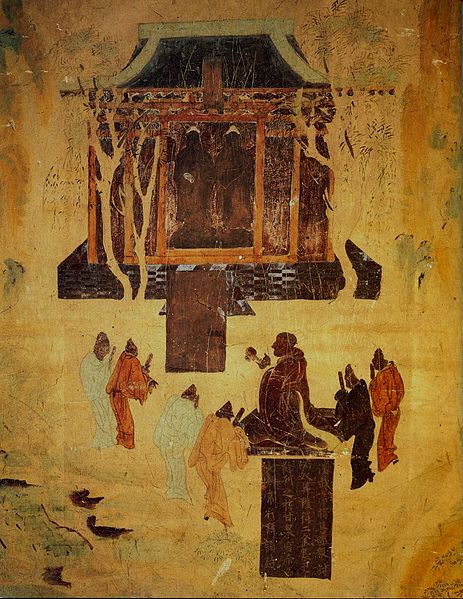Zhang Qian was a Chinese diplomat, explorer, and politician who served as an imperial envoy to the world outside of China in the late 2nd century BC during the Western Han dynasty. He was one of the first official diplomats to bring back valuable information about Central Asia, including the Greco-Bactrian remains of the Macedonian Empire as well as the Parthian Empire, to the Han dynasty imperial court, then ruled by Emperor Wu of Han.
Zhang Qian taking leave from emperor Han Wudi, for his expedition to Central Asia from 138 to 126 BC, Mogao Caves mural, 618 – 712...
Statue of Zhang Qian in Shaanxi History Museum, Xi'an
Countries described in Zhang Qian's report. Visited countries are highlighted in blue.
Mogao Caves 8th-century mural depicting the pseudohistorical legend of Emperor Wu of Han worshipping "golden man" Buddha statues captured in 121 BC.
The Han dynasty was an imperial dynasty of China, established by Liu Bang and ruled by the House of Liu. The dynasty was preceded by the short-lived Qin dynasty (221–206 BC) and a warring interregnum known as the Chu–Han contention (206–202 BC), and it was succeeded by the Three Kingdoms period (220–280 AD). The dynasty was briefly interrupted by the Xin dynasty (9–23 AD) established by the usurping regent Wang Mang, and is thus separated into two periods—the Western Han and the Eastern Han (25–220 AD). Spanning over four centuries, the Han dynasty is considered a golden age in Chinese history, and had a permanent impact on Chinese identity in later periods. The majority ethnic group of modern China refer to themselves as the "Han people" or "Han Chinese". The spoken Sinitic language and written Chinese are referred to respectively as the "Han language" and "Han characters".
Western Han painted ceramic jar with raised reliefs of dragons, phoenixes, and taotie
Reverse side of a Western Han bronze mirror with a painted flower motif
Statue of a horse trampling a Xiongnu warrior, at the mausoleum of Western Han general Huo Qubing (d. 117 BC), who fought in the Han–Xiongnu War. This is the first known monumental stone statue in China.
The ruins of a Han-dynasty watchtower made of rammed earth at Dunhuang, located at the eastern edge of the Silk Road








